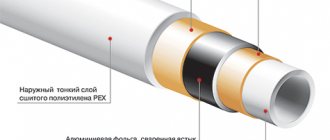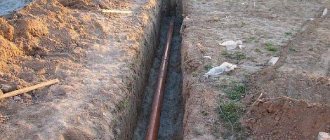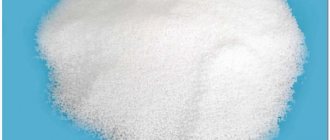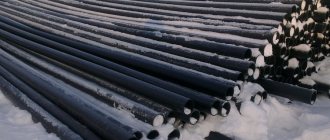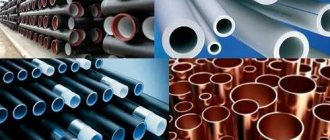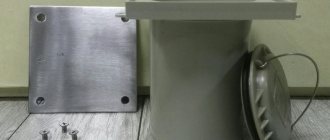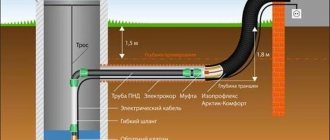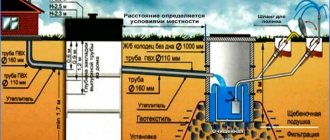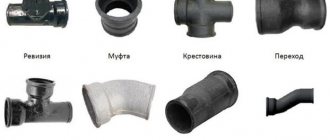The construction of communications brings real comfort to country life, but their open location does not have the best effect on the aesthetic component of the site. It is a completely different matter if the sewer pipeline is buried in the ground: it is not visible, the pipeline does not interfere with movement.
However, for the underground installation of the system, compliance with rules and regulations is necessary. They should be studied, don’t you agree?
The fundamental laws and subtle nuances according to which sewer pipes are laid in the ground are presented on our website. Based on the information we offer, you will build a trouble-free external sewer system.
A pipeline constructed in accordance with our advice will work perfectly at any time of the year. The article presented to your attention scrupulously describes the technology for constructing the underground part of the sewer system.
The material describes the nuances of design and installation details. Recommendations are given on the implementation of preventive measures and compliance with sewerage operating rules. To make it easier to understand, the information is supplemented with photo images and video instructions.
Features of autonomous sewerage
Today, almost every household has the necessary set of amenities for a comfortable stay: washbasin, sink, toilet, shower or full bath, washing machine and other amenities of civilization. Many houses are equipped with not one, but several bathrooms and bathrooms.
This entire facility, when fully operational, produces a large amount of waste and wastewater per day. According to standards, the amount of liquid waste per person per day is from 5.4 to 9.5 liters, which must be discharged somewhere.
As a rule, country houses where people live permanently have many different plumbing fixtures, which makes it necessary to equip an autonomous sewer system
Therefore, the drainage system is an obligatory part of the engineering communications of an individual house. It consists of an internal sewerage system, an outlet from a residential building and an external sewerage network laid on the site.
Many owners of private houses, paying special attention to the intra-house system, for some reason do not always properly approach the arrangement of external networks.
Indeed, the process of laying a pipeline seems simple; it is enough to dig a trench, connect the pipes to each other, the intra-house system and the collector, and then cover everything with earth.
But this is only at first glance. In fact, in this, as in any other work, there are many nuances that must be taken into account. Failure to comply with technological standards and improper installation of the pipeline may in the future lead to siltation and other significant problems.
In order for the sewer system to function properly and for a long time, its installation must adhere to construction and technological standards (+)
The drainage system must ensure the removal of all wastewater, eliminate the possibility of flooding of the building in the event of emergency situations, and ensure the treatment of wastewater when discharged into a reservoir.
When arranging the system, it is necessary to take into account such parameters as the material of manufacture and the diameter of the pipes, the type of soil in the area, the depth of laying sewer pipes, and a certain slope angle.
Autonomous sewerage systems for private households can be carried out in the form of separate or joint drainage and treatment. In the first case, two separate pipelines are made for wastewater from washbasins, bathtubs and sinks and for fecal matter from the toilet.
In the second case, all liquid and solid waste are combined into one common stream and entered into a septic tank, where they undergo a cleaning process, and then removed.
Image gallery
Photo from
Laying a sewer pipeline
The starting stage of construction of a sewer pipeline
Slope to ensure free flow
Height of insertion into the treatment system
Internal circuit
The development of the scheme should begin with the most distant plumbing fixture installed on the top floor. The horizontal lines drawn must necessarily come to the riser. To save materials for work, plumbing fixtures are placed on different floors, but maintaining the same vertical.
The home sewer system includes:
- A water seal that protects the room from unpleasant odors;
- Pipes through which wastewater enters the external system;
- Knees;
- Tees;
- Clamps that support pipes and create a certain slope;
- Central riser
When installing a sewer system, it is very important to monitor the transition of pipes. It should not move from a larger diameter to a smaller one. To take this nuance into account, you need to install the toilet on the layout at the closest distance from the riser.
The drawing of the internal system includes several very important parameters:
- Number of floors;
- Basement;
- Number of plumbing fixtures;
- Number of apartments.
The diagram must be drawn to a certain scale. This will help you quickly understand the pipe layout when you need to identify problems in the event of an emergency.
Selection of pipes for the device
Previously, when laying sewers, only metal pipes were used: cast iron or steel. Indeed, these materials are like no other suitable for laying in the ground. They are strong, durable, low cost, and easy to install.
However, along with advantages, metal structures also have significant disadvantages. The disadvantage of steel lines is the possibility of corrosion, and cast iron pipes are heavy.
In terms of strength and durability, cast iron pipes have no equal; this material can lie in the ground for decades without losing its qualities, but due to their heaviness, laying a water pipeline becomes much more difficult
A certain difficulty is present in sealing the joints of a cast iron pipe, as well as its internal surface, which, due to the characteristics of the material, will never be perfectly smooth. The latter characteristic affects the speed and quality of movement of waste inside it; over time, blockages can form in the pipe.
Asbestos-cement pipes can be used for sewer installation. They have a smooth surface, which eliminates the possibility of blockages, are simply connected using special couplings, and their weight is significantly less than that of metal structures.
But they also have a significant disadvantage - they are very fragile, which complicates their transportation and installation. Ceramic pipes have the same fragility.
Reinforced concrete structures have many advantages: they have exceptional strength, water resistance, and frost resistance. It is possible to make large-diameter pipes from reinforced concrete, which is impossible to do from other materials.
But laying such pipes is a big problem - due to their heavy weight, it is necessary to use special equipment, which is not always advisable in an individual household.
Today, when installing private sewer systems, polymer pipes are most often used, which, despite their strength, are lightweight, which allows them to be installed by one person. They are very simple and easy to connect, resulting in excellent tightness.
Orange polymer pipes are used for the installation of external sewerage. They have increased strength compared to gray pipes intended for internal piping, and also have the ability to withstand heavy loads
There are three types of polymer pipes - polypropylene, PVC or HDPE (low-density polyethylene). PVC structures, in addition to the above advantages, are also resistant to UV radiation and have slight changes in parameters due to temperature changes.
However, the PVC sewer pipeline does not withstand very low and very high temperatures, and can also be deformed under mechanical loads.
During its operation, the sewer system is subject to dynamic loads, which are best withstood by corrugated pipes. Even if it freezes, the integrity of the line will not be compromised, but deformation of its walls may occur.
The diameter of the pipes is selected based on the amount of plumbing equipment installed in the house. So, for a country cottage with two toilets, pipes with a cross-section of 110 mm will be sufficient.
If the house building has three or more bathrooms, it is necessary to use a pipeline with a diameter of 160 mm.
Image gallery
Photo from
Polymer pipes in the installation of an external branch
Polypropylene products in sewerage organization
Cold welding pipe connection
Range of fittings for plastic pipelines
Rules and limits for system depth
Some people mistakenly believe that the deeper the sewer is located, the more efficient it will work. However, it is not. This will not improve the performance of the system; the only thing that will increase is the cost of installing it.
In addition, maintenance of the sewer network will become more difficult. And the biggest disaster can happen if, as a result of heaving or erosion of the soil, the pipes cannot withstand its pressure and burst.
When laying sewer pipes, it is necessary to adhere to the norms and rules set out in SNIP 2.04.03-85. An important parameter that must be taken into account when installing a pipeline is its depth in the ground.
Despite the fact that the regulatory act does not provide clear parameters for the depth of pipes, the document indicates which criteria are decisive when laying a sewer line.
Typically, in central Russia, pipes are laid to a depth of 0.8-1.4 m, which is quite sufficient for the efficient functioning of the sewage system (+)
According to SNiP, it is necessary to be guided by the climatic conditions characteristic of the region, in particular the level of soil freezing, and the experience of operating sewer networks that has developed in the area.
If there is no information about the operation of the sewer system, then the minimum depth of the pipeline should be 30-50 cm above the freezing level.
In this case, there must be a distance of at least 70 cm from the surface of the earth to the top of the pipe. If the pipeline passes under a concrete platform or in places where vehicles move, the minimum recommended depth of the pipeline should be increased to 0.9-1 m.
In addition, when arranging an external network, it is necessary to take into account the material of the pipes and the composition of the soil, since the freezing depth of different types of soil is not the same.
Clay and loamy soils in the same area freeze less than fine sand and sandy loam. Coarse and gravelly sand have the highest level of freezing.
From the table below you can see how different the freezing depth of different types of soil in the same city is.
When is it used?
It is impossible to organize normal conditions for a comfortable life in a house without a sewer system. Passing through the internal pipeline, waste is transported to external mains, along which it reaches the septic tank.
If pipes are laid in trenches correctly, such a system can exist for several decades. To organize a sewer system, trenches are first dug.
There are several situations when rutting is necessary:
- pipes should not be located in a visible place on the site;
- the distance from the object to the septic tank is large and it will not be possible to lay a pipe on the surface;
- climatic conditions;
- compliance with regulatory requirements;
- protection from mechanical damage;
- saving land on the site.
There are situations when laying pipes in trenches is impractical. This is influenced by the harsh climatic conditions in which a tenth of the country lives.
For example, if the average annual temperature in a region is too low, then permanent frost is observed. Sewage pipes laid in the ground may freeze. Because of this, they are placed on the surface of the earth. The location on top of the ground is also convenient for repair work.
Also, laying a pipe underground does not make sense if the outer section is small. Then you can install sewer pipes on top of the ground, leading them to the septic tank.
Insulation of sewer pipeline
The efficiency and durability of external sewerage largely depends on properly performed insulation. This is especially important in northern regions and when pipes are laid above the freezing level. To understand how important insulation is, you need to imagine how the system works in the cold season.
During the passage of liquid, which always has a positive temperature, the pipe is partially filled with liquid waste. Water vapor also fills the pipe.
In winter, at subzero temperatures, the part of the pipe located closer to the surface cools, which leads to the formation of condensation, and then frost, which rushes to the center of the pipe, which often causes blockages.
Molded insulation is selected based on the diameter of the pipe, before laying the sewer line, it is simply put on top
High-quality insulation of the pipeline allows you to avoid the formation of frost and blockages, as well as protect the system from freezing. It can be done using different materials that are abundantly available on the market today: foamed polyethylene, polystyrene foam, isover, thermal insulation and others.
Insulation materials can be rolled or molded. The first are wound onto the pipe while it is being laid in the basement. Thermal insulation shell made of foamed polyethylene has a similar application.
They are not used as thermal insulation for underground lines. Mostly molded insulation is used, which is made for a specific pipe diameter. Thermal insulating material of the required diameter is simply placed over the sewer pipe.
One of the most popular insulation materials is Energoflex, which is made from extruded polystyrene foam. The closed cell structure of the material prevents the penetration of groundwater, which can significantly reduce the insulating properties. Foil casing enhances efficiency
If the temperature in the region is very low, then insulation alone is unlikely to be a reliable protection of pipes from freezing. In this case, a heating cable is usually used, which is laid along the outside of the pipe inside the heat-insulating material.
When using a heating cable, you need to ensure that the joints are completely sealed to prevent moisture from leaking inside.
Image gallery
Photo from
Laying sewerage in a cold basement
Application of thermal insulation shell
Using a heating cable
Laying pipes below the freezing level
External line
To install a sewer system for an individual house, it is necessary to draw a diagram taking into account the surrounding landscape. Professionals recommend placing the septic tank as low as possible, and the pipes should have a slight slope.
To determine which treatment system needs to be taken as a basis and at what depth the pipes will lie, you need to pay attention to the following factors:
- Groundwater;
- Type of soil;
- Freezing depth.
The construction of external sewerage usually begins with laying a pipeline from the foundation. Drains should be discharged towards the constructed cesspool. Any turn of the pipe must be equipped with a special revision, in the form of an adapter equipped with a lid. Through it you can easily remove the blockage.
An inspection well is mounted on the outside and a ventilation hood is installed.
The ventilation pipes exit through a riser with an installed drain pipe. Since it will always have a very strong unpleasant odor, such a pipe should be installed as far as possible from the windows or next to the smoker.
It is prohibited to combine the fan pipe with an ordinary ventilation shaft. The umbrella can be replaced with a special vacuum valve installed at the top of the riser. Remember that it has nothing to do with the check valve.
Forming a slope for free flow
When laying the pipeline, it is necessary to provide a slope towards the septic tank. According to technological standards, the slope of a sewer pipe with a diameter of 110 mm should be 20 mm for each meter of pipeline. Pipes with a diameter of 160 mm must be laid with a slope of 8 mm per meter of laid line.
When laying pipes, the slope is calculated for one meter of pipeline. The figure shows how much the difference should be between the sides of pipes with different diameters
The presence of a slope is a determining parameter for the successful functioning of the system. The closer the pipeline performance is to the standard, the more efficient the sewage system will work.
A complete lack of slope, as well as excessive slope of the pipeline, will lead to siltation of the system. In the first case, waste will not be able to be transported through the pipes at the required speed, which will lead to the formation of blockages.
In the second, the liquid will move too quickly, which will ultimately reduce its transport capacity, and waste will remain in the pipe, which will also lead to blockages and further silting of the pipeline.
The slope of the pipeline should always be directed from the outlet of the residential building towards the septic tank. This condition is especially important when using non-pressure sewers, which are most often equipped in private households.
You can control the slope level of the entire trench using a special device - a level. If the device is not available on the farm, then the slope is checked using a building level.
Procedure:
- At the beginning and end of the pit, pins are driven in to which the cable is tied.
- A building level is applied to one end of the rope and adjustments are made to the horizon.
- The height of the trench is measured from both sides to the cable.
- Simple mathematical calculations are performed.
For example, the total length of the trench is 50 m, a pipe with a diameter of 110 mm is used. On the exit side of the house, the depth of the pit is half a meter. In this case, at the end point of the pit, its depth should be equal to one and a half meters.
Detailed technology for calculating sewer slope is described in this article.
If the site has a natural slope that exceeds the recommended standards, it is possible to lay a sewer system with several vertical transitions. In this case, on horizontal sections of the pipeline it is necessary to comply with regulatory indicators.
In areas with a large slope, the pipeline can be laid in a stepwise manner. If the slope angle slightly exceeds the standards, they are limited to one vertical transition (+)
Another option is to lay a vertical pipe at the exit from the house to a considerable depth, and then lay a pipeline from it with the required slope. In this case, the depth of the trench will be greater than when laying using the first method.
For the same purposes, you can use a drop well, into which wastewater flows smoothly to a lower level of the pipeline.
Professional design
In addition, if the owner of a private residential plot has the right to make a mistake, he can design a sewer system at his own peril and risk
To organize even a small enterprise, to draw up plans for the improvement of urban or courtyard areas, carefully calculated, technically sound projects are required that fully comply with all existing sanitary and construction standards.
Such design and survey work is carried out by special organizations that have state certification to carry out activities of this kind
.
When contacting specialists, the customer presents them with a number of documents that will form the basis of the technical specifications:
- Topographical diagram of the territory from which stormwater is expected to be drained.
- Geological survey data containing information about the nature of the soils on the site.
- General development plan.
- If you plan to discharge into a centralized collector system
, the technical conditions of the water utility services for connection. - Sanitary standards for water purification if it is intended to be discharged into natural reservoirs or drainage fields.
- Possible customer wishes for organizing the accumulation of collected water.
The result of the designers’ work is a package of documents, which includes:
- General information about the site being developed and storm drainage.
- Detailed schematic diagram of storm drainage.
- A scaled drawing-plan of the site with reference to the locations of all elements of the storm drain. In essence, it is a ready-made installation instruction for further work.
- Detailed specification of the equipment required according to the technical specifications.
- A full estimate for the purchase of the required materials and construction, installation and commissioning works.
The finished storm sewer project is subject to mandatory approval from water utility companies, state technical supervision authorities, the sanitary-epidemiological service, and the environmental control service in charge of the state of water resources.
Only after the project has been fully approved by all regulatory authorities can its practical implementation begin.
Some design organizations take on the entire process of approving the project they have developed.
The design process is complex, but there are no trifles in this matter.
In order for the storm sewer to fully fulfill its functions, so as not to incur penalties for violations of environmental legislation, it is better to entrust the development of the project to experienced specialists whose qualifications are not in doubt.
Pipe laying work
Technologically, the process of laying sewerage is not particularly difficult. First you need to dig a trench, the depth of which corresponds to the standard indicators characteristic of the given region.
Before laying sewer pipes, sand is poured into the bottom of the ditch. The height of the sand base is 10-15 cm, so the depth of the trench should also be increased by these values.
A sand cushion allows you to level the bottom of the ditch. Before laying pipes, the sand must be thoroughly compacted to prevent subsequent shrinkage.
The width of the trench is laid approximately 40 cm larger than the diameter of the pipe used. At the points where the pipes approach the septic tank and at the exit from the house sewer system, the trench is made a little wider so that it is convenient to carry out installation work.
To prevent the foundation and walls of the house from getting wet in the event of an emergency leak, the septic tank is installed at a distance of no closer than 5 m from the building (+)
After the trench and base are prepared, it is necessary to connect the pipes together and then lay them. It is beyond the power of one person to lay long sections of the highway evenly and correctly, so it is advisable to involve several assistants in this work.
There are special rubber seals at the ends of the pipes. Before joining them to each other, silicone plumbing grease is applied around the perimeter of the pipe, which facilitates the joining process and makes the joint more reliable.
But you cannot use force here; excessive force on the pipe can damage the rubber band or tear it out of its seat, which will lead to a violation of its tightness.
Before laying the prepared pipeline, a pipe is placed at the exit from the house drainage system, which has the required angle. The other edge of the line fits into the hole in the septic tank.
If the storage well was made recently, it is advisable not to immediately seal the hole with concrete, since the pipe may burst when the septic tank shrinks.
A pipe placed on the pipe leaving the house allows you to direct the pipeline in the desired direction
Backfilling a sewer pipe is carried out as follows: first, sand is poured so that the pipe is completely covered with it. Then it is watered with water, and after it shrinks, another batch of sand is added. After this, the highway is completely covered with earth.
According to technical standards, rotary wells must be installed in places where the route turns, and inspection wells must be installed on straight sections of the pipeline for every 35 m. In addition, every 15 meters of the direct line an inspection or cleaning is installed.
Installing an inspection is a simple procedure, but it allows you to monitor the condition of the sewer network throughout the entire pipeline and, if necessary, clean the desired area with a cable or a stream of water
The revision can be made from the same sewer pipe, which is installed vertically in the required sections of the pipeline using a tee. It is closed with a plug on top. Using this fairly simple device, you can quickly access a clogged section of the line.
It is better to install a manhole in the most critical sections of the network.
Connection format
- Welding is the most complex, requiring special knowledge and the use of equipment. Welding is performed on metal and plastic pipes. Such connections are extremely inconvenient in cases where repairs are necessary.
- Bell-shaped - a section of one pipe is installed in the socket of another. Sealing of joints is achieved through the use of rubber seals and sealants. When using this method, when installing cast iron pipes, additional caulking is done with tow.
- Socketless (flange, coupling) - pipes that are straight at both ends are placed butt-to-butt, a rubber cuff is applied to the joint and tightened with a clamp. The socketless connection method is most convenient for repairs and replacements of sewerage sections.
By analyzing which underground sewer pipes are most suitable in a particular case, you will get rid of many problems associated with the difficulties of cleaning and repair.
The article was written for the site.
Tags:Pipes
Actions to take when the sewer freezes
If you have not insulated your sewer pipes, or have not insulated them sufficiently, and they are frozen, first of all, you need to identify the damaged section of the pipeline in order to choose a method to solve the problem. Metal pipes can be heated using a blowtorch.
If the pipeline is made of plastic, open fire cannot be used. You can pour hot water into the sewer, in which you have previously dissolved salt (2 kg per 10 liters of water). You can direct a stream of steam or hot water to the revision closest to the frozen area.
If the damaged pipe is located in the middle of the main line, you can use a steam generator to warm the soil. However, this process can take quite a long time. It is best to prevent the system from freezing, and when laying pipes, provide them with high-quality thermal insulation.
Conclusions and useful video on the topic
This video covers the process of laying external sewerage in great detail, and also provides regulatory indicators that must be adhered to during installation:
This video shows how to lay sewer pipes in the ground:
Despite its apparent simplicity, the work of laying sewer pipes requires a competent approach and knowledge of regulatory laying rules. Only if the necessary indicators are observed and the work is carried out correctly, can a truly effective and durable sewer system be installed.
Are you trying to install sewer pipes yourself? Or maybe you don’t agree with the material presented? We welcome your comments and questions – the contact form is located below.
How to lay sewer pipes in a private house: step-by-step instructions
A person feels good where there are comfortable living conditions. And in order to create them, you need to think about how to lay a sewer system in a private house. Firstly, you should familiarize yourself with the features of this process, and secondly, decide on the material used.
It is worth noting that now, plastic pipes, albeit slowly, are still replacing metal pipelines. As for cast iron, they are used very rarely due to their weight and high cost. In contrast, polymer products are much lighter in weight, easier to install and durable.
